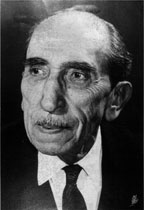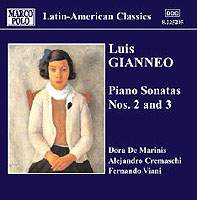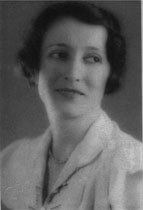
|
Biography |
|
|
||||||
Luis Gianneo was one of the leading composers of his generation. Profoundly Argentinian, he was one of the first and most succesful creators to strive for a national music with contemporary significance. Most of his mature musical output shows traces of folk elements, woven into a neo-classical musical language, sometimes angular, other times lyrical, but always full of life and momentum.. As a composer, he became one of the most important predescesors of Alberto Ginastera, who in many occasions expressed his admiration for Gianneo, and whose music shows interesting parallelisms with the older composer.
Gianneo was a tireless musician and educator. He was extremely active teaching, conducting and performing in the northern province of Tucuman for more than twenty years. Later, upon his return to Buenos Aires he formed and conducted several youth orchestras. He was one of the few composers of his generation who chose to remain in his home country to develop a musical tradition from within instead of seeking recognition abroad. Complete biography Luis Gianneo was born in Buenos Aires on 9th January 1897 into a musical family of Italian immigrants. Unsurprisingly he began his musical studies at an early age under the leading teachers of the time. He was a piano pupil of Luigi Romaniello and Ernesto Drangosh and studied composition with Constantino Gaito and Eduardo Fornarini. When Fornarini moved abroad, Gianneo relied on his own resources for further study.
During his earlier years Gianneo formed a violin and piano duo with his brother Miguel and also accompanied distinguished visiting violinists, while there were performances of his own first chamber and piano compositions. In 1921 he married the pianist and singer Josefina Ghidoni, and in 1923 moved with his family to the northern city of San Miguel de Tucumán on the invitation of his brother-in-law, a well-known cellist, working first as a teacher at the Tucumán Instituto Musical, of which he later became director. For twenty years he continued in Tucumán as a teacher, pianist and orchestral conductor, active with his wife in stimulating local musical life. Here he introduced practically all his compositions and performed a great deal of contemporary music by composers such as Stravinsky, Debussy and Respighi. He founded and directed the Philharmonic Association, presided from 1935 over the prestigious Sociedad Sarmento, and collaborated with the Review of the institution, contributing, in the first issue, in April 1936, a long article on his much admired Stravinsky, whose neo-classical principles he followed and whose influence is clearly reflected in his orchestral Obertura para una Comedia Infantil (Overture to a Children’s Play), first performed in 1937 under his direction in a concert of the Tucumán Asociación Sinfónica. In 1932 Gianneo joined the Grupo Renovación, founded in 1929 by the brothers Juan José and José Maria Castro, Jacobo Ficher and Juan Carlos Paz. Gianneo, however, was never able to identify completely with some of the principles of the group, especially with those of Juan Carlos Paz, whose radical ideas and fixed absolutist attitudes he did not share. Their differences came to a head in 1952, when Paz published an article in the Buenos Aires Musical in which he denied the technical and creative ability of those who did not share his musical ideas, a proposition openly opposed by Gianneo. The fame of Gianneo had already spread further afield, with acclaim in Buenos Aires for works such as El Tarco en Flor, Pampeanas and Turay-Turay, and important performances of his works in major cities of the interior. In addition to participation in a large number of concerts as pianist, conductor or composer, he also served as organist at the Church of St Francis. In these fruitful years in Tucumán he was greatly helped by his wife and his daughters, Celia, a fine pianist, and Brunilda, a talented violinist. In 1938 Gianneo travelled to Europe with his family with an award from the National Cultural Commission, absorbing there the latest musical trends and visiting Italy, France, Germany, Belgium and Switzerland. In Florence he attended the International Music Congress and in Turin conducted the Orchestra of the Royal Conservatory in his symphonic poem Turay-Turay as part of a concert devoted to the work of Argentinian composers. In Paris he wrote his Cinco pequeñas piezas (Five Little Pieces) and the Sonatina for piano, the First Symphony and the Concertino-Serenata. At the beginning of 1939, some months before the outbreak of war, the family returned to Buenos Aires, where they finally established themselves in 1943. In 1945 Gianneo founded the Argentinian Youth Orchestra for Radio El Mundo, and then, in 1954, the Youth Symphony Orchestra of Radio Nacional. He served as director of the National Conservatory and was a member of the Cultural Commission and the Academy of Fine Arts. Awards for his compositions included the Prize of the Free Library of Philadelphia for Latin-American Composers for his Concierto Aymara for violin and orchestra, first performed at the Teatro Colón in 1944, and the Municipal Prize of the City of Buenos Aires for his Transfiguración for baritone and orchestra. Commissioned works included the Variaciones sobre un tema de tango (Variations on a Tango Theme) for the Friends of Music Association, Piano Sonata No. 3 for the Association of Chamber Concerts, the symphony Antífona for Radio Nacional, the cantata Angor Dei for the Tucumán Musical September and the Obertura del Sesquicentenario, his last work, for the Organization of American States. The first ten years back in Buenos Aires brought Gianneo increasing fame, with frequent performances of his music. His work as a teacher was as intensive as it had been in Tucumán, with pupils that included Rodolfo Arizaga and Virtú Maragno, and later the famous conductor Pedro Ignacio Calderón and Ariel Ramirez, the very distinguished pianist and composer of traditional Argentinian music. In 1949 Alberto Ginastera invited him to serve as Professor of Harmony, Instrumentation and Composition at the recently created Conservatory of Music and Drama of La Plata. From 1955, after the coup d’état that ousted General Perón, Gianneo was appointed inspector of the National Conservatory. In the same year his wife died suddenly, after a short illness. Soon afterwards his two daughters moved to Europe for further study and he spent a number of years alone before marrying Inés Rosa Sayans in 1960. With her he travelled to Europe, sent by the Ministry of Education to study new methods of musical education. Gianneo’s son Luis Alejandro was born in Rome in 1961. He dedicated his 1962 cantata Angor Dei to his wife, and to his son the 1965 Poema de la Saeta. In the latter year he was elected President of the Argentinian Society for Music Education. In 1967 he undertook his third journey to Europe, making contact there with state broadcasting stations, academies and theatres, to promote the performance of Argentinian music. He died eight months after his return to Buenos Aires, on 15th August 1968, while revising the score of Transfiguración for a coming performance. Dora
De Marinis |


